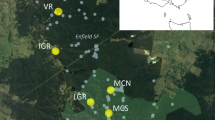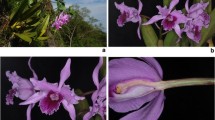Abstract
For evolutionary and ecological analyses, genetic diversity at different scales needs to be studied in terms of biological properties, habitat, population size and population history. We surveyed Platanthera bifolia populations from six regions in northeastern Poland to determine the impact of the mating system and population history on genetic diversity. Based on variation at allozyme markers, genetic variation was relatively moderate (P = 22.3%, A = 1.48, H O = 0.083, F IS = −0.015) and similar to other Platanthera species. These parameters varied between populations (P = 13.3%–26.6%, A = 1.26–1.66, H O = 0.055–0.111, F IS = −0.262–0.147). The genetic diversity patterns were shaped by different proportions of facilitated selfing and/or outcrossing, resulting in positive and negative F IS values, respectively. No relationship between inbreeding coefficient and population size, however, and no impact of apomixis on the level of genetic diversity of P. bifolia were found. The relatively low level of genetic differentiation among the investigated regions (F CT = 0.002, P > 0.05) and among populations (F ST = 0.048, P < 0.001), and the lack of a significant relationship between genetic and geographical distance, are discussed in the context of possible scenaria of postglacial expansion.



Similar content being viewed by others
References
Ackerman JD (1998) Evolutionary potential in orchids: patterns and strategies for conservation. Selbyana 19:8–14
Adamowski W (1996) Apofityzm wybranych gatunków storczykowatych (Orchidaceae) i jego uwarunkowania ekologiczne (Apophytism of orchid species (Orchidaceae) and its ecological conditioning). PhD. Thesis, Warsaw University, Białowieża
Adamowski W (1998) Colonization success of orchids in disturbed habitats. In Falińska K. (ed) Plant population biology. W. Szafer Institute of Botany, PAN, Kraków, pp 165–172
Barrett SCH, Husband BC (1990) The genetics of plant migration and colonization. In Brown AHD, Clegg MT, Kahler AL, Weir BS (eds) Plant population genetics, breeding and genetic resources. Sinauer Associates, Sunderland, pp 254–277
Bowless ML (1999) Eastern prairie fringed orchid Platanthera leucophaea (Nuttall) Lindley. Recovery Plan for Region 3. U.S. Fish and Wildlife Service, Fort Snelling. Unpublished manucript. Available at: http://www.fws.gov/midwest/endangered/plants/
Brzosko E (2003) The dynamics of island populations of Platanthera bifolia in the Biebrza National Park (NE Poland). Ann Bot Fenn 40:243–253
Brzosko E, Wróblewska A (2003a) Low allozymic variation in two island populations of Listera ovata (Orchidaceae). Ann Bot Fenn 40:309–315
Brzosko E, Wróblewska A (2003b) Genetic variation and clonal diversity in island Cephalanthera rubra populations from the Biebrza National Park. Bot J Linn Soc 143:99–108
Brzosko E, Ratkiewicz M, Wróblewska A (2002a) Allozyme differentiation and genetic structure of Lady's slipper island populations (Cypripedium calceolus) in NE Poland. Bot J Linn Soc 138:433–440
Brzosko E, Wróblewska A, Ratkiewicz M (2002b) Spatial genetic structure and clonal diversity of island populations of Lady's slipper (Cypripedium calceolus) from the Biebrza National Park (northeast Poland). Molec Ecol 11:2499–2509
Cockerham CC (1969) Variance of gene frequency. Evolution 23:72–84
Cowden NFF (1993) A biosystematic study of Platanthera ciliaris, P. blephariglottis, and P. ×bicolor, emphasizing the northern portion of their range. Ph.D. Dissertation, Miami University, Oxford, Ohio
Dafni A (1992) Pollination ecology: a practical approach. Oxford University Press, New York
Ellstrand NC, Ellam DR (1993) Population genetic consequences of small population size. Implications for plant conservation. Annual Rev Ecol Syst 24:217–242
Forrest AD, Hollinsworth ML, Hollinsworth PM, Sydney C, Bateman RM (2004) Population genetic structure in European populations of Spiranthes romanzoffiana set in the context of other genetic studies on orchids. Heredity 92:218–227
Frankham R, Ballou JD, Briscoe DA (2003) Introduction to conservation genetics. Cambridge University Press, Cambridge
Gitzendanner MA, Soltis PS (2000) Patterns of genetic variation in rare and widespread plant congeners. Amer J Bot 87:777–786
Goodwillie C, Kalisz S, Eckert CG (2005) The evolutionary enigma of mixed mating systems in plants: Occurrence, Theoretical Explanation, and Empirical Evidence. Annual Rev Ecol Evol Syst 36:47–79
Goudet J (2001) PCA-GEN, ver. 1.2. Institute of Ecology, Lausanne. Available at: http://www2.unil.ch/popgen/softwares/pcagen.htm
Hamrick JL, Godt MJW (1989) Allozyme diversity in plant species. In Brown AHD, Clegg MT, Kahler AL, Weir BS, (eds) Plant population genetics, breeding, and genetic resource. Sinauer Associates, Sunderland, pp 43–63
Hamrick JL, Godt MJW (1996) Effects of live history traits on genetic diversity in plant species. Philos Trans Royal Soc Biol Sci 351:1291–1298
Hardy OJ, Vekemans X (2002) SPAGeDi: a versatile computer program to analyse spatial genetic structure at the individual or population levels. Molec Ecol Notes 2:618–620
Hultén E, Fries M (1986) Atlas of north European vascular plants north of the tropic of cancer. Koeltz Scientific Books, Königstein
Johnson SD, Edwards TJ (2000) The structure and function of orchid pollinia. Pl Syst Evol 222:243–269
Kahmen S, Poschlod P (2000) Population size, plant performance, and genetic variation in the rare plant Arnica montana L. in the Rhön, Germany. Basic Appl Ecol 1:43–51
Legendre P, Legendre L (1998) Numerical ecology. Ed. 2. Elsevier Science BV, Amsterdam
Lloyd DG, Schoen DJ (1992) Self-fertilization and cross-fertilization in plants. I. Functional dimensions. Int J Pl Sci 153:358–369
Loveless MD, Hamrick JL (1984) Ecological determinants of genetic structure in plant populations. Annual Rev Ecol Syst 15:65–95
Maad J (2002) Selection and floral evolution in Platanthera bifolia and P. chlorantha (Orchidaceae). Comprehesive Summaries of Uppsala Dissertations from the Faculty of Science and Technology. Acta Universitatis Upsaliensis, Uppsala
Maad J, Alexandersson R (2004) Variable selection in Platanthera bifolia (Orchidaceae): phenotypic selection differed between sex functions in a drought year. J Evol Biol 17:642–650
Maad J, Reinhammar LG (2004) Incidence of geitonogamy differs between two populations in the hawkmoth-pollinated Platanthera bifolia (Orchidaceae). Canad J Bot 82:1586–1593
Machon N, Bardin P, Mazer SJ, Moret J, Godelle B, Austerlitz F (2003) Relationship between genetic structure and seed and pollen dispersal in the endangered orchid Spiranthes spiralis. New Phytol 157:677–687
Miller MP (1997) Tools for population genetic analyses (TFPGA) 1.3: A Windows program for the analysis of allozyme and molecular population genetic data. Available at: http://www.marksgeneticsoftware.net/tfpga.htm
Mitton JB (1989) Physiological and demographic variation associated with allozyme variation. In Soltis DE, Soltis PS (eds) Isozymes in plant biology. Dioscorides Press, Portland, pp 127–145
Nazarov VV, Gerlach G (1997) The potential seed productivity of orchid flowers and peculiarities of their pollination systems. Lindleyana 12:188–204
Nei M (1978) Genetic distance between populations. Amer Naturalist 106:283–292
Nilsson LA (1978) Pollination ecology and adaptation in Platanthera chlorantha (Orchidaceae). Bot Notiser 131:35–51
Nilsson LA (1988) The evolution of flowers with deep corolla tubes. Nature 334:147–149
Nilsson LA (1992) Orchid pollination biology. Trends Ecol Evol 7:255–259
Nybom H (2004) Comparison of different nuclear DNA markers for estimating intraspecific genetic diversity in plants. Molec Ecol 13:1143–1155.
Peakall R, Beattie AJ (1991) The genetic consequences of worker ant pollination in a self-compatible, clonal orchid. Evolution 45:1837–1848
Raymond ML, Rousset F (1995) GENEPOP (version 1.2), a population genetics software for exact tests and ecumenism. Heredity 86:248–249
Richardson BJ, Adams M, Baverstock PR (1986) Allozyme electrophoresis: a handbook for animal systematics and population studies. Academic Press, Sydney
Rosenwich UL, Pettway RE, McDonald BA, Duncan RE, Frederiksen NA (1999) Genetic structure and temporal dynamics of Colletotrichum greminicola populations in a sorghum disease nursery. Phytopathology 88:1087–1093
Schneider S, Roessli D, Excoffier L (2000) ARLEQUIN ver. 2.000. A software for population genetics data analysis. Available at: http://www.anthro.unige.ch/arlequin
Slatkin M (1993) Isolation by distance in equilibrium and non-equilibrium populations. Evolution 47:264–279
Smith GR, Snow GE (1976) Pollination ecology of Platanthera (Habenaria) ciliaris and P. blephariglottis (Orchidaceae). Bot Gaz 137:133–140
Soltis DE, Soltis PS (1989) Isozymes in plant biology. Dioscorides Press, Portland
Sun M, Wong KC (2001) Genetic structure of three orchid species with contrasting breeding systems using RAPD and allozyme markers. Amer J Bot 88:2180–2188
Tatarenko IV, Vakhrameeva MG (1998) On vegetative propagation in orchids. Byul Bot Sada I.S. Kosenko 7:155–157
Vekemans X, Hardy OJ (2004) New insights from fine-scale spatial genetic structure analyses in plant populations. Molec Ecol 13:921–935
Vogler DW, Kalisz S (2001) Sex among the flowers: the distribution of plant mating systems. Evolution 55:202–204
Wallace LE (2002) Examining the effects of fragmentation on genetic variation in Platanthera leucophaea (Orchidaceae) Inferences from allozyme and random amplified polymorphic DNA markers. Pl Spec Biol 17:37–49
Wallace LE (2006) Spatial genetic structure and frequency of interspecific hybridization in Platanthera aquilonis and P. dilatata (Orchidaceae) occurring in sympatry. Amer J Bot 93:1001–1009
Weir BS, Cockerham CC (1984) Estimating F-statistics for the analysis of population structure. Evolution 38:1358–1370
Wright S (1943) Isolation by distance. Genetics 28:114–138
Acknowledgements
We are grateful to Adam Hermaniuk and Edyta Wasilewska for assistance in the field and in the laboratory, and thankful to Teresa Grużewska and Teresa Świerubska for helping us locate Platanthera bifolia populations in the Narew Valley and Suwałki Lakeland. The study was done under project 2P04C 048 30 financed by the Polish Ministry of Science and Higher Education.
Author information
Authors and Affiliations
Corresponding author
Rights and permissions
About this article
Cite this article
Brzosko, E., Wróblewska, A., Tałałaj, I. et al. Patterns of Genetic Diversity in Platanthera bifolia (Orchidaceae) with Respect to Life History Traits and Recent Range Expansion. Folia Geobot 44, 131–144 (2009). https://doi.org/10.1007/s12224-009-9033-1
Received:
Accepted:
Published:
Issue Date:
DOI: https://doi.org/10.1007/s12224-009-9033-1




